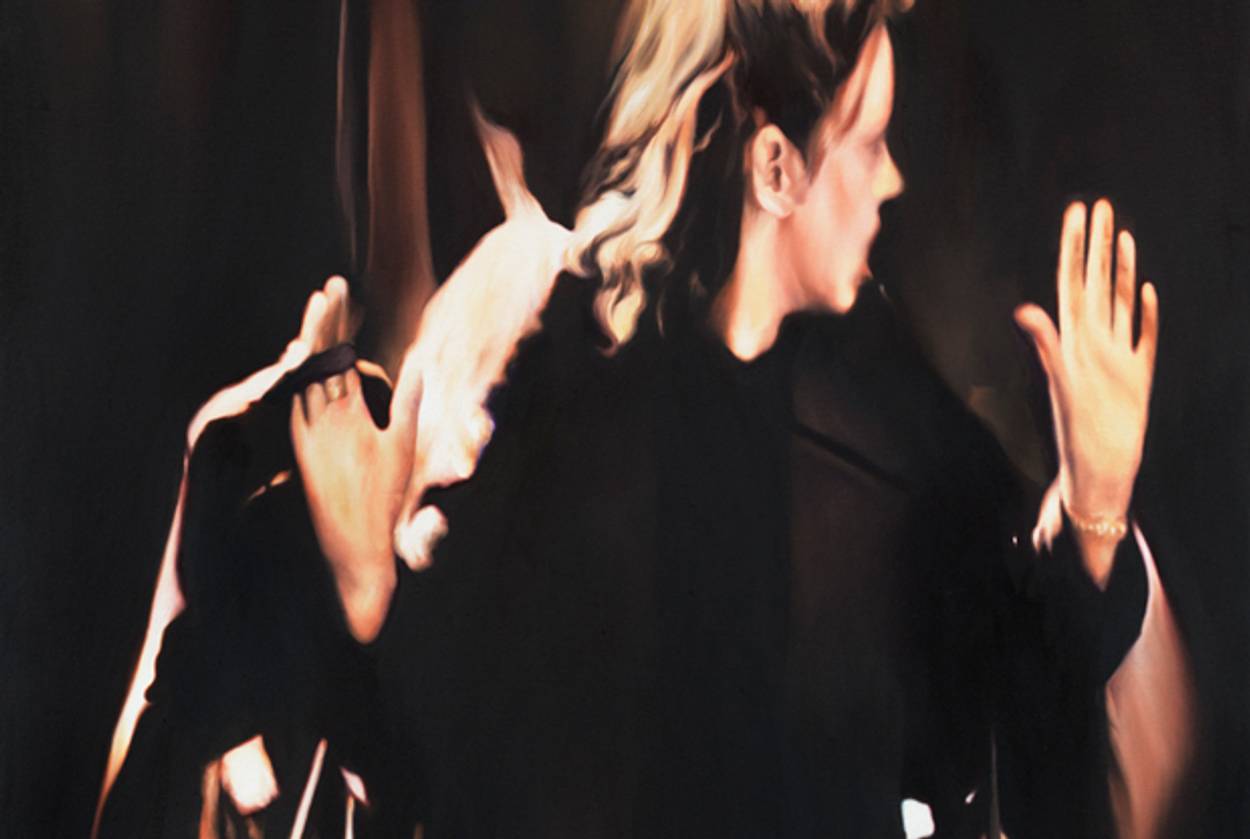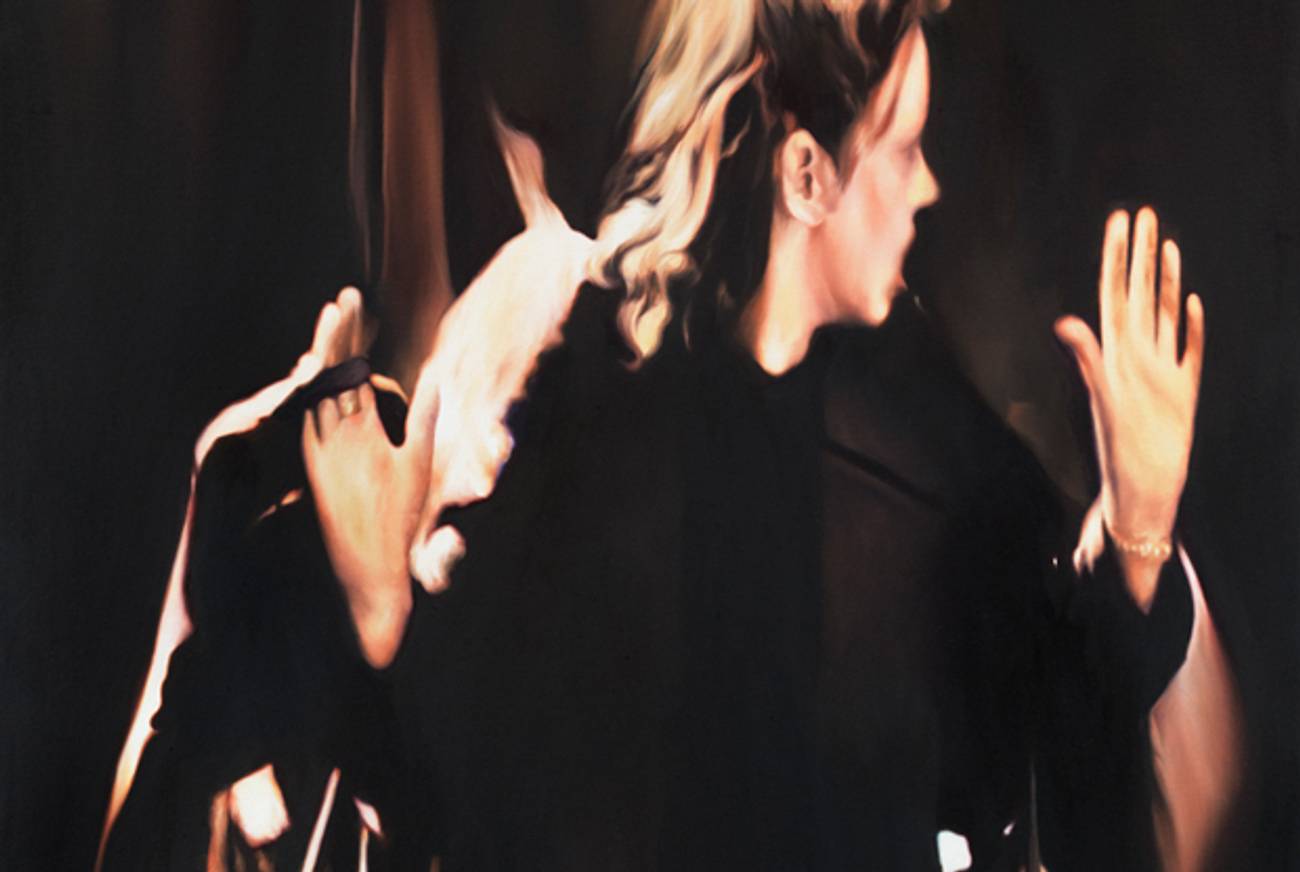Holocaust Imagery as Art
Israeli artist Nir Hod transforms a famous photograph from the Warsaw Ghetto into a Cindy Sherman-style portrait of a modern fashionista




You’ll feel like you’ve seen her before, this elegant woman laden with bags.
Not just because Nir Hod’s gallery show, opening Wednesday at Paul Kasmin in New York, features nine near-identical paintings of her in a row—plus a big one on the back wall—each rendered in a different tone, kind of like Andy Warhol’s Shadows. With her classic style; her dark hair pinned in artful disarray; her wary gaze fixed on something outside the frame, she resembles a Cindy Sherman film still, one of those archetypal females enmeshed in a noirish drama. Or maybe she’s just hailing a cab after a long day of shopping.
That’s exactly what Hod wants you to think. Only after you behold this frazzled beauty and ponder her story (is that a face on her fabulous leather tote?), he hopes, will you examine a small silver plate on a wall. On it is printed a photograph. That’s when you realize the woman’s look of timeless chic is really Warsaw, circa 1943. To her left is a small boy wearing a big cap and short pants, wobbly-kneed and vulnerable, hands in the air; behind them are more Jews at gunpoint. The picture, from SS Major General Jürgen Stroop’s report celebrating the liquidation of the Ghetto, is often described as the most famous Holocaust image in history.
“My plan is they will see the show, then they turn around and see it in a completely different way,” the artist told me. “That will be the twist.” He added, “Then when you discover where it comes from, you feel, like, guilty.”
This series, called Mother, is the latest provocation from Hod, a 40-year-old Israeli who describes his biggest obsessions as beauty and death. His sultry works playing with those themes—along with gender, stereotypes, archetypes, and his own angelic good looks—have made him a pop-culture star in his native country (and a fixture of post-Zionist shows overseas), particularly his paintings of apparently female soldiers who are, in fact, often men (including himself) in drag. In New York, where he has lived since 1999, he’s best-known for his Geniuses, paintings depicting louche pre-adolescents with smoking habits, which sold out at Kasmin last May. So, at the gallery’s Armory Show stand earlier this month, Hod showed work from a different series, of mirrors painted with renderings of huge lines of cocaine.
In his newest series, he’s revisiting some of his obsessions, but on sacred ground. Summoning his chutzpah, his canny fashion sense, and his close study of Warhol and Richter, Hod has turned a Holocaust victim into a fashion plate.
That’s cheeky, even for a professional transgressor like Hod. Though he had famously painted an Israeli military funeral, now he’s sampling one of the most seen, scrutinized, and cited pictures of World War II, subject of countless discussions about its role in our perception of history, memory, and trauma, to name a few, not to mention the debate over the identity of the poignant, terrified boy in the front, whose potential re-emergence as a grown-up survivor was provocative, too. (Some people thought the boy’s power as a symbol would diminish if he had survived; his true identity was never confirmed.) Along with the ultra-Orthodox protesters who recently conjured the boy in a kind of political street theater, a vast spectrum of artists have referenced the photo, from magical-realist Samuel Bak, whose Icons of Loss—reimagining the boy in numerous non-Warsaw scenarios—are on view at Toronto’s Holocaust Education Centre, to conceptualist Gustav Metzger, whose “Historic Photographs” were at New York’s New Museum last year. In the gallery, the artist enlarged the original Warsaw Ghetto photo to mural size and then blocked it with construction rubble. The idea was to make it a sort of social sculpture that made it hard to see an image that had gotten too familiar.
Hod, too, has long been obsessed with the image. Earlier in his career he’d tried dressing up as the boy, in a photo and a sculpture, but they didn’t have much impact. Strangely enough, he says, a photo of Hillary Clinton brought to mind the woman in the front, how her contrapposto stance draws the eye to the boy. “I said, ‘Wow, this is so powerful, the way she’s standing in the shadow all these years,’ ” the artist said in his Gansevoort St. studio. He decided he needed to rescue her. So, he cropped her out of the Ghetto.
Stylistically, Mother descends from other photo-based paintings of tragic beauties caught in the sweep of history—think Warhol’s Jackie Kennedy, or Richter’s semi-glamorized terrorist Ulrike Meinhof. ButHod’s goal is distinct. Though the Woman in the Front does, in some archives, have a name—in 1999 her husband evidently identified her as Chana Zeilinwarger—Hod is not interested in that identity. To borrow a name coined by another Kasmin artist, Deborah Kass, in a very different context, Mother is no Jewish Jackie. She is simply fabulous. Rather than Treblinka, she could be heading to the Standard Hotel for cocktails.
That leather tote with the ghostly pug-nosed face (an apparent optical illusion copied faithfully enough from the original picture) “could be Yves Saint Laurent, or Prada. It can be Dolce, or Hermès,” Hod said. Each Mother has a floating wood frame embellished with gold leaf. “I want to push it to fashion,” he added. “I want to create it as a luxury object.”
From that perspective, he’s succeeded. The gallery says that most of the paintings, which were originally offered at around $75,000, have been sold. Each one comes with a reproduction of the original photo, though it’s not clear what the new owners might do with it. So, in Mother’s future incarnations, she might not necessarily be Polish, or a Holocaust survivor, or a even a mother. She’ll be the woman with the bags.
In other cases, though, she’ll send viewers back to the original, at least to see how Hod pulled off this audacious act of appropriation. Maybe in that sense it’s more interesting to think of Mother not as paintings but as social sculpture—just like Metzger’s “Historic Photographs,” he made you look. For that you have to give Hod credit. He managed to bring Chana Zeilinwarger out of the shadows after all.
***
Like this article? Sign up for our Daily Digest to get Tablet Magazine’s new content in your inbox each morning.
Robin Cembalest is executive editor of ARTnews. She blogs at letmypeopleshow.com. Her Twitter feed is @rcembalest.
Robin Cembalest is executive editor ofARTnews. She blogs at letmypeopleshow.com. Her Twitter feed is @rcembalest.